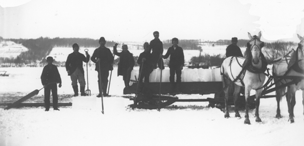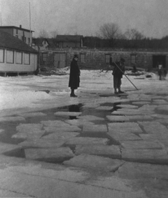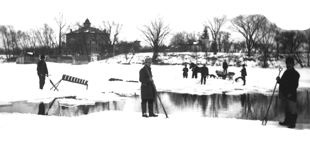|
Lewis Potts was a well-known person in the Penn Yan area. Some years ago an oral history project was begun here at the Oliver House Museum. Luckily, Mr. Potts was interviewed and his recollections were transcribed. Following are his memories of harvesting ice on Keuka Lake, a job that he did for over 25 years. Open your refrigerator, your freezer. Look at the other appliances that you own that makes your life easier. Now, read what Mr. Potts and others like him had to do just to keep our food cold!
Lewis Potts' Ice Cutting on Keuka Lake
 My experience with the ice business started in June 1919 when I was hired to help in peddling ice for the Keuka Lake Ice Company in Penn Yan. My experience with the ice business started in June 1919 when I was hired to help in peddling ice for the Keuka Lake Ice Company in Penn Yan.
In that particular year the ice was very thin and the harvest was very, light. When some of the cakes came out of storage you had to place two together in tongs to have them hold.
My next experience to tell about would be the ice harvest which started about the 28th or 29th of December, 1919 which was the earliest in the history of ice harvest where the average date was, January 25th. We started in December and we had such a bad winter (such deep snow that hindered harvest) that we never completed the harvest until sometime in March. When we started harvesting, we used the old fashioned equipment, which was a horse plow, which would go down across the ice field and make a groove. If that groove wasn't deep enough according to the thickness of the ice, you would repeat that until you went down half or maybe two-thirds through the cake. Before we had been harvesting for any great length of time we had two gasoline ice saws, which were very similar to a regular buzz saw which worked along behind a motorized power plant that furnished the power to operate the saw.
 As we went down, after we made the first cut across, the next cut was made with a gauge that extended out from the equipment into the first groove so that it kept them uniform. The ice was cut in cakes of 22 x 32, a rectangular shape. Before we ever cut ice in the fall, as the lake began to freeze, we would go out every so often with an auger and go through the ice to get the depth for two reasons. Sometimes a windstorm would come up and blow the weeds in the lake bottom and loosen it and they would form in the ice, which made the ice useless. We started normally at a 10-inch depth. We would watch the lake surface to pick out a clear field. Come time for cutting we would go out the first thing in the morning and cut crosswise. We would cut so much the 32 in. width and then change and go crosswise with the 22 in. size which made the cakes 22 x 32, as I said before. Then we had to cut a channel in the ice from the field where we were cutting down to the trestle. That was also cut with a saw to a certain depth. We never cut clear through the ice with a saw. We cut a certain way and then we finished off with a hand- saw with a handle on one end so that the man down the other end wasn't down under the water. We would cut a channel of a width that would take the width of three to four cakes - floats we called them - normally three wide, possibly four, and anywhere from ten to twenty cakes long. They went down the channel endways and when they got down to where the trestle was, there was a bumper. The cakes went lengthwise until they came to this bumper and just before they got to the bumper we had a bridge across the channel where a man stood with a long handled pole and broke the cakes loose in strips of three from the float. When they came to this bumper they stopped and were cut there into single cakes. As we went down, after we made the first cut across, the next cut was made with a gauge that extended out from the equipment into the first groove so that it kept them uniform. The ice was cut in cakes of 22 x 32, a rectangular shape. Before we ever cut ice in the fall, as the lake began to freeze, we would go out every so often with an auger and go through the ice to get the depth for two reasons. Sometimes a windstorm would come up and blow the weeds in the lake bottom and loosen it and they would form in the ice, which made the ice useless. We started normally at a 10-inch depth. We would watch the lake surface to pick out a clear field. Come time for cutting we would go out the first thing in the morning and cut crosswise. We would cut so much the 32 in. width and then change and go crosswise with the 22 in. size which made the cakes 22 x 32, as I said before. Then we had to cut a channel in the ice from the field where we were cutting down to the trestle. That was also cut with a saw to a certain depth. We never cut clear through the ice with a saw. We cut a certain way and then we finished off with a hand- saw with a handle on one end so that the man down the other end wasn't down under the water. We would cut a channel of a width that would take the width of three to four cakes - floats we called them - normally three wide, possibly four, and anywhere from ten to twenty cakes long. They went down the channel endways and when they got down to where the trestle was, there was a bumper. The cakes went lengthwise until they came to this bumper and just before they got to the bumper we had a bridge across the channel where a man stood with a long handled pole and broke the cakes loose in strips of three from the float. When they came to this bumper they stopped and were cut there into single cakes.
They came down lengthwise and went on to the trestle crosswise so they changed the position of the cake. They had an elevator up to a certain degree where it took the ice up high enough that they could be loaded into freight cars. We loaded the cars at the ice trestle; going up the grade was a two-chain elevator, with wooden bars across with chains across the outside end. We called them bars; the cake to the bar was possibly four feet apart. When they got to the top of the grade, they changed off on to a single chain trestle and the trestle was high enough so that they could unload off the trestle down into freight cars, six cars on each side. That's the way we loaded them.
At the very beginning, there was quite a bit of slant, from the top of the trestle down to the bottom of the cars. We would put them in layer after layer. Normally there would be about five layers. On rare occasions six - but it was generally five layers. The cars were loaded to a tonnage of 35 to 50 tons to a car according to the size. If we didn't load 42 cars a day, we didn't- figure we bad done a day's work. As I say, we had cars loaded on both sides and during the day when we were loading, the switch engine was there. As soon as one string of six were loaded, they would take that away, and we would put the men across the trestle and load the other side while they were going out with the loaded cars to bring in another string of empties. We loaded six cars to a time. There would be one man standing on the walk somewhat below the trestle level (top of the trestle level) and stand on this walk. As the cakes came along they had an ice pick and they would reach out and catch a corner of the ice pick in the cake and the motion of the chain would push the cake off down into the cars. Two men worked in the car, one on each end. Normally it would take an average of possibly an hour to load a car.
We never started until the ice was 10 inches and sometimes when we had extremely cold weather we might be cutting ice as thick as 18 inches. As each cake of ice came up over the trestle, it came under a double-edged planer and that purpose was to cut off the snow ice or dirt on top of the ice. If the cakes of ice were too thick to handle efficiently, they also cut off so much ice from the top of the cake down to a standard thickness. We have cut ice from around 220 to 350-360 lbs. and a cake of ice 350-360 lbs. is too heavy to handle.
 Normally in cutting ice we would go to work anywhere from 5:30 to 6 in the morning, to have ice cut for that day because we never cut it ahead of time because the water would work in and freeze up your field. We tried to, as far as possible, start each day with a new field. Also, the channel would freeze up overnight and we had to open up the channel every morning or sometimes we would leave ice in the channel from the field and then that was messed up so it was no good to use. We would then cut that ice loose with saws or spuds and push it underneath to get it out of the way. Normally in cutting ice we would go to work anywhere from 5:30 to 6 in the morning, to have ice cut for that day because we never cut it ahead of time because the water would work in and freeze up your field. We tried to, as far as possible, start each day with a new field. Also, the channel would freeze up overnight and we had to open up the channel every morning or sometimes we would leave ice in the channel from the field and then that was messed up so it was no good to use. We would then cut that ice loose with saws or spuds and push it underneath to get it out of the way.
As I spoke before, the icehouse was built in the fall of 1922 and finished early in 1923. I personally laid almost every roof board on that big building, if you will notice how big it is. Also as an employee of the ice company, I had charge of part of the construction of putting in the trestlework, the elevator-and the runs used to run the ice into the rooms. There were six rooms there and we used to as a rule put ice into four rooms at a time, because they were getting the surplus that they weren't using for cars. When we got through loading cars, all the rest went into the icehouse pretty fast. Of 30,000 tons, 10,500 went into the building and the rest went to various places.
A fine customer was the New York Central railroad. I won't attempt to say how many cars - probably there would be 15,000 tons that was shipped away in cars. We also shipped ice to local places that had small icehouses. That took a carload or two in the building. There was a company in Seneca Falls, which used a considerable number of cars, which we filled, from here in Penn Yan. At one time they got their ice in Geneva when ice was cut on the lake over there. There were two or three different outfits that were cutting ice on the lake in Geneva and they got in a squabble over territory, so the state stepped in and surveyed it off and they paid for so many acres if they wanted it at that time.
As the ice came over this trestle and under the planer that I spoke of, it formed a vast pile of scrap ice. To get rid of that, it piled up so badly we had to have a bucket full of water to wash that away anywhere we could put it. There was a lot to look after.
They used to say that I had the easiest job on the place. All I had to do was to look after the men. Well I had to climb that elevator 45 ft. to the top many times a day and I had 42 men to look after, loading the cars, operating the trestle, putting ice on the trestle, putting ice off the trestle to go up into the ice house, cooling off the apparatus in front of the building into the rooms. It was a busy job and I did it for quite a number of years.
After about 1930 the man who owned the ice company died and the business was sold to a man who knew nothing about ice harvesting. As a matter of fact when we went to work for the ice harvest in 1919, the man who owned it didn't know any more about ice harvesting than we did. We learned with it (another man who worked with me by the name of Mace). I was with the company for over 25 years and he stayed about five years after I left. We learned the business and after two or three years when we had been there long enough, the original owner left it up to us to get the ice harvested. He sold it to another man who knew less about ice harvesting than we did. We talked it over that if he came up there and knew enough about the ice harvest which he didn't know to mess us up, we would just step out and let him harvest it. I was told afterwards, the original owner said, "Leave the boys alone and they will get your ice." And we did. Almost every year we learned some new little quirk so that we could do it a little better, a little faster and all that sort of stuff. It wasn't simple. Generally people would come up there on Sundays and watch the ice harvest.
Ice harvest was a big business at that time.
The first year it started in December and ended up in March. But after we had been harvesting with the new equipment, new trestle and new building, and experience, we would harvest the 30,000 tons of ice within six weeks at the very most. We learned how to do things the quickest, easiest and best way. When it came time for ice harvest there were certain men who worked at the same job year after year. When it came time for ice harvest they would come up and put in their names for the job. I did the hiring and I did the firing, very little firing. When ice harvest was over, their job was over and that was it for another year. As a rule we had the same men. We had the same crew and a few extras were put on as required. My job was a year round job. Some of our best help were farmers. Men who knew how to work and would work. The morning that we would start cutting ice there would be easily 100 men or more looking for a job. Some of them were men who had already been hired, so to speak, ahead of time and others I filled in with people that I knew would work or that I thought would work. I did the hiring and if necessary, I did the firing.
The cars used in the wintertime for shipment were regular boxcars or cattle cars because the weather was cold and it was immaterial. In the summertime when we loaded ice for the FGE at Watkins or other places like that, they were loaded in refrigerator cars. We had an elevator that when we were icing cars by hand would carry the ice from the trucks up to the top of the cars. Before we got that we would toss it up by hand.
Back towards the end of the ice harvest we got, as I recall, about 40 to 45 cents an hour and they earned it. When the new man took over he wanted to pay the old hands 45c or whatever it was, and cut the new men 5 or 10 cents less because they weren't capable. I said, "Nothing doing. The new men are going to work harder than the old men because it takes skill and strength and the new men will work harder than the old men to do the same thing and if they don't do it they won't stay." |
